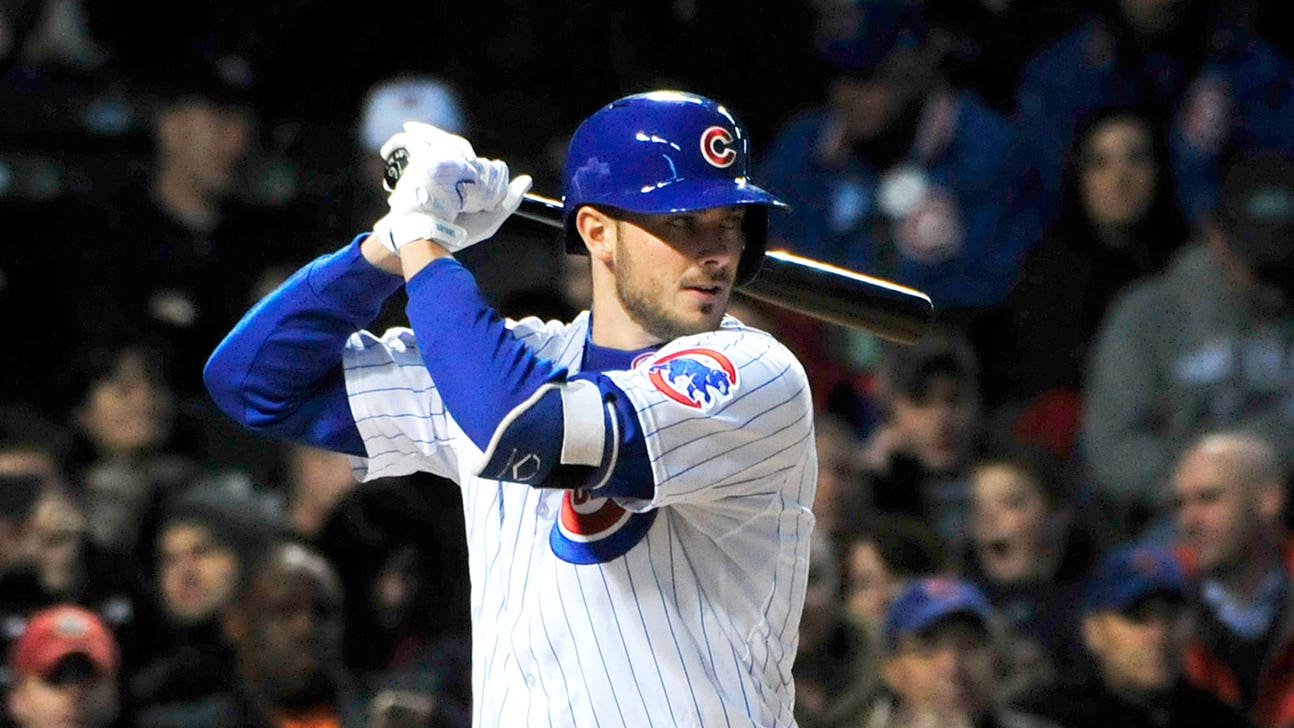
Pitchers putting Bryant in rare class
Kris Bryant finally did it. After not hitting a home run in 20 games following his call-up, he went out on Saturday in Milwaukee and clubbed a Kyle Lohse slider 389 feet out to left-center. The homer was the one number conspicuously missing from his season statistics, but it was always coming: the 23-year-old put up famous power numbers in the minor leagues, he’s been hitting inside fastballs to the warning track in right-center, and there was nothing telling that anything was wrong. Part of his power drought was surely his ongoing adjustment to major-league pitching, something all rookies have to contend with. However, his treatment by pitchers so far shows just how unique Bryant might be, and puts him in a rare class of hitters.
Unsurprisingly, there was something special about the home run Bryant hit, beyond it being the first of many in his career. Here's a look at it, slowed down at impact, with a bit of an effect on the ball to make it more visible:
There are a few things to note: It was a slider, it was on the first pitch of the at-bat and it was over the outer third of the plate. It caught more of the strike zone than Lohse wanted, but it wasn’t the worst hanging slider anyone has seen. This serves first and foremost as a reminder that Bryant is very talented at hitting baseballs. It also informs us of the approach we’ve seen pitchers use when attacking Bryant so far in his young career, and the adjustments he needs to make in order to be successful at this level.
Lost in the frenzy over a big-power prospect not hitting home runs is the fact that hitting for power requires getting good pitches to hit (unless it's Vladimir Guerrero). Usually, a hitter doesn’t view a first-pitch slider on the outer third of the plate to be a great candidate for a home run to left-center field, but this is where Bryant currently finds himself.
Here are the names of players since the year 2000 with at least 17 walks in their first 21 career games:
That’s it — five players. Not all of these hitters lit the world on fire, but they were/are known as high OBP/power guys (with the exception of LaRoche). The bottom line is that this happens very rarely, and Bryant is being treated in a unique way usually reserved for a certain type of hitter.
What’s driving the incredible walk total for Bryant? He’s simply not seeing many pitches in the strike zone. These are the 10 players in 2015 that have seen the lowest percentage of pitches in the zone, coupled with the percent of pitches they swung at outside of the strike zone:
There are two groups of players on this chart. One are the free swingers who hack at a lot of pitches outside of the strike zone: Evan Gattis, Matt Adams, Eric Hosmer, and Pablo Sandoval. They swing at pitches outside of the strike zone far more often than the league average (30 percent). There isn’t much need to throw strikes to these hitters, because they’ll get themselves out a lot by swinging at bad pitches.
The other group is made up of the scary guys. Pitchers avoid throwing strikes to David Ortiz and Anthony Rizzo because pitches in the strike zone often get hit very far over meaningful fences. To be fair, the players in the first group are no slouches when it comes to power; they’re just not the fearsome all-around offensive threats the second group represents.
Bryant finds himself among the second group. So does Joc Pederson. You could view this as pitchers testing these rookies to see if they will bite at pitches out of the zone, and that’s valid — that is part of this pitching approach. However, both of these players are also big power threats, with Bryant especially hailed as the next big thing in power hitting (he hit 43 homers last year in the minors). Pederson and Bryant’s percents of pitches in the strike zone would be the lowest marks for rookies since we started keeping this type of data (2002). This is about testing young hitters, but it's also about respect. And fear.
What also separates Bryant and Pederson from most new call-ups: plate discipline. Here are the top 10 hitters in 2015 in terms of pitches per plate appearance:
Rarely are rookies on this list, especially one month into the season. This year, there are two. Not only are these two rookies being pitched to in an exceedingly rare manner, but they're also disciplined enough to work the count and take walks when they're given.
Now that we know pitchers are avoiding throwing strikes to Bryant, let’s look into what pitches they’re throwing him, and where. To begin with, let's go back to the home run Bryant hit on a first-pitch slider. That's indicative of the pattern he has seen at the plate so far: he has the 14th-lowest rate of first-pitch fastballs out of all major-league hitters this year (also of note: Lohse has thrown the most first-pitch breaking balls in the majors this season, so Bryant also does his homework).
Pitchers are either trying to get in on the hands or keep the ball away from Bryant, mostly looking to exploit the outer part of the plate to get swings-and-misses down and away. Just look at the pitches Bryant saw during his four-walk game last Monday against the Cardinals to get an idea (view is from the catcher's perspective):
There's a lot going on, but you can see the idea: try to get Bryant inside off the plate, or get him to chase pitches low and away.
Cubs manager Joe Maddon told reporters before last Wednesday’s game that Bryant was "getting pitched to as if he won the Triple Crown last year." One expects a certain amount of hyperbole from major-league managers, but Maddon is onto something. Bryant, he of 22 career major-league games, is being pitched to like Ortiz and Rizzo. In terms of walks, that’s something almost never seen before. Yes, he is striking out a lot, and the power has been almost absent since his call-up. We knew the former was going to happen, and the latter shouldn't be a worry. Bryant knows what he needs to do: be patient, take his walks, and force pitchers to come back into the zone. When they do, like on a hanging slider this past weekend in Milwaukee, he’ll be waiting.




